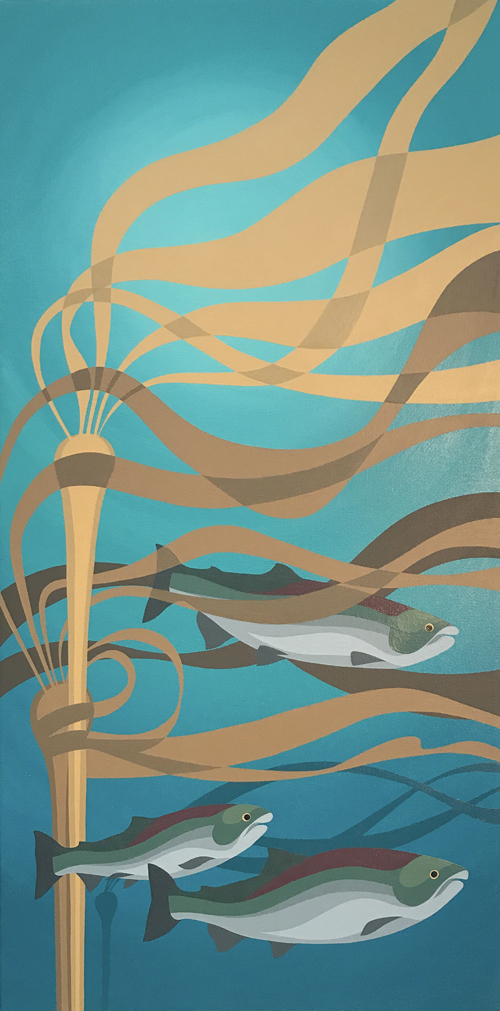Kelp forests are classified as major habitats integral to the health of BC’s marine ecosystem and serve as the home for a large food web of fish and invertebrates. The Bullwhip kelp grows in cold ocean water from Northern California to Southern Alaska, usually in areas with strong currents in channels between islands.
The kelp reaches 30 meters in height and attaches to the seafloor with “roots” that act as a strong anchor in turbulent waters. The long stipes are topped with a hollow bulb which is filled with carbon monoxide for flotation. Long, wide fronds grow from the bulb up to 18 meters and serve as a home to various species of prawn, snails, brittle stars, sea stars, anemones, urchins, crabs, rockfish, sea lions, seals, migrating salmon, grey whales and sea otters.
Running Wild – 2018 – 18″x36″ – (sold)
Description
Kelp forests are classified as major habitats integral to the health of BC’s marine ecosystem and serve as the home for a large food web of fish and invertebrates. The Bullwhip kelp grows in cold ocean water from Northern California to Southern Alaska, usually in areas with strong currents in channels between islands.
The kelp reaches 30 meters in height and attaches to the seafloor with “roots” that act as a strong anchor in turbulent waters. The long stipes are topped with a hollow bulb which is filled with carbon monoxide for flotation. Long, wide fronds grow from the bulb up to 18 meters and serve as a home to various species of prawn, snails, brittle stars, sea stars, anemones, urchins, crabs, rockfish, sea lions, seals, migrating salmon, grey whales and sea otters. Sea otters help control urchin populations which can quickly decimate an entire kelp forest and are pointed to as the cause for kelp decline in Howe Sound. Gulls, terns, egrets, great blue herons, and cormorants also dine on the many fish and invertebrates living in the kelp.
Sockeye Salmon are among the most revered salmon species along the BC coast by both the commercial fishing industries and the First Nations peoples. Overfishing, freshwater stream disturbance and warming waters account for recent unpredictable fluctuations in runs.
Wild populations of salmon are also increasingly threatened by commercial open net-cage salmon farms which are a breeding ground for pests and diseases such as Sea Lice, Piscine Orthoreovirus (PRV) and Heart and Skeletal Muscle Inflammation (HSMI). These are documented transmitting to wild fish populations and have a devastating impact on young salmon entering the ocean from nearby rivers. Many fish farmers also treat their fish with pesticides and antibiotics which when released into the ocean can harm shrimp, prawns and crabs.
Matted Prints are standard sizes in a double white mat $45
- Giclees printed on archival cotton fine art paper
- Acid, lignin and chlorine free
- High quality Epson inks
- Double mat fits standard frame sizes
- Made in Canada

Canvas Prints – various sizes and prices
- Archival cotton canvas Giclee prints stretched over 1.5″ wide wooden stretcher bars
- Additional coating of museum grade protective UV varnish
- Basis Weight: 430 gsm, Material: Cotton, Surface Finish: Satin, Thickness: 23 mil
- Certificate of Authenticity
- Edition limited to 150 prints
- Signed by the artist and embellished with fresh paint
- Wired and ready to hang
- Printed in Vancouver, BC to the highest modern printing standards
- Made in Canada


Additional information
| Media | Canvas Print, Matted Print |
|---|---|
| Size | 10" x 20", 12" x 24", 15" x 30", 18" x 36", 20" x 40", 24" x 48", 5″ x 10″ print in 8″ x 12″ mat |


